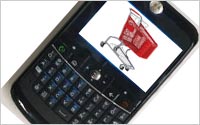 According to the new ForeSee Mobile
Satisfaction Survey, the majority of people using their mobile phone as a shopping tool while in a store are actually going to that retailer’s Web site. More than 6,200 consumers were surveyed
during the holiday 2012 shopping season, and 62% of those using their phone in-store said they were going to the store’s site. Another 20% were using the store’s app.
According to the new ForeSee Mobile
Satisfaction Survey, the majority of people using their mobile phone as a shopping tool while in a store are actually going to that retailer’s Web site. More than 6,200 consumers were surveyed
during the holiday 2012 shopping season, and 62% of those using their phone in-store said they were going to the store’s site. Another 20% were using the store’s app.
While still
substantial, the fear of brick-and-mortar stores that rivals can poach their customers via mobile may be overstated. Thirty-seven percent of respondents said they were referencing a competitor’s
site in the store and 21% said they were using shopping comparison tools.
While 55% of those using m-shopping were doing price checks, 40% were comparing products, and 29% were checking specs
and reviews. Overall, however, 70% of mobile phone users were accessing their devices while in-store.
The ForeSee study suggests that the mobile phone plays a complex role in the purchase
process, but the results also underscore the challenge of determining that effect. For instance, while 36% of people visiting a retailer mobile site or app said they came with the intention of buying
something on the site, far fewer (26%) actually made the purchase on their phone. And yet 86% of visitors to the mobile site said they either did end up purchasing from the company on some channel or
intended to do so in the future.
Within the increasingly complex multichannel customer journey, mobile is emerging as a secondary screen, albeit an indispensable one. Only 6% of people started
their research or shopping for a product from their phone. The desktop Web (56%) was far and away the most popular starting place. But interestingly, those who started in either place shared the same
level of satisfaction with the retailer’s online experience (both scoring 80 on a 1-100 satisfaction scale).
And while only a small fraction of shoppers started on the mobile site or
app, 21% said hitting the mobile site at some point was part of the purchase path. And ultimately, 20% said they ended up making the purchase on the mobile channel.
Also interesting is
that in a few cases -- namely Apple and Foot Locker, Gilt, and Buy.com -- consumers now find the mobile experience superior to the desktop experience for the respective brands.
In terms of
ranking the top retailers for consumer satisfaction with their mobile presence, Amazon (85) and Apple (83) were ranked highest, as were QVC (83), NewEgg (80) and Victoria’s Secret
(80).